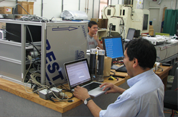Climate Variability
Monitoring Climate Variability from Reference Tropospheric Water Vapor and Temperature Measurements
(The best examples of phd dissertation and our other projects can be found at the main page of the site.)
While changes in aerosols play an important role in forcing climate, trends in atmospheric water vapor and temperature are important indicators of climate variability. It has long been recognized that the surface based upper-air sonde observation stations over the US that monitor these variables, are inadequate for climate monitoring and research because of siting, accuracy, and precision issues. The impact of the multitude-types of sondes launched across the globe without sufficient documentation of their performance and accuracy has resulted in data sets that have limited the understanding of climate trends and the community from making definitive statements regarding recent climate change. Satellite observing systems have a poor vertical resolution, and inconsistency in continuity associated with drift in orbits and/or lifetime. More recent missions “have demonstrated better station control but still are not adequate for climate purposes unless they can be suitably validated.” (GCOS-112; 2007). Unlike radiosondes, passive satellite observations of microwave and infrared brightness temperatures sample relatively thick atmospheric layers (and may include surface emissions), depicted as weighting functions. While these thick layer estimates offer robust large sample stability, they are limited in quantifying the variations within these thick layers. This is especially important in the mid-to-upper troposphere and lower stratosphere (CCSP, 2006; Chapter 2).
NASA Goals
The NRC has recognized these limitations in measurement systems and has recommended to NASA in the recent Decadal survey report that a systematic and sustained research should be undertaken. Specifically, “Recommendation: Critical surface-based (land and oceans) and upper-air atmospheric sounding networks should be sustained and enhanced as necessary to satisfy climate and other Earth science needs in addition to weather.” (Decadal survey page 3-7). This is also in agreement with the National Academies Review of NASA/SMD in 2006 which states “The committee recommends that NASA begin immediately to develop a science strategy for obtaining long-term, continuous, stable observations of the Earth system that are distinct from observations to meet requirements by NOAA in support of numerical weather prediction.” (“Review of the Science Mission Directorate's (SMD's) Draft Science Plan: Letter Report 2006”) Because the errors that arise from the above limitations in satellite as well as radiosondes and that the errors cannot be unambiguously removed from the historical archive, it makes it harder to investigate climate trends. This fact has created a scientific need for establishing a network of stations that are designed to address the climate research needs. NOAA and the GCOS (Global Climate Observing System) community through WMO have established the requirements for such a network: GCOS Reference Upper-Air Network (GRUAN). GRUAN, “a network for atmospheric reference observations, is required to provide the foundation for long-term datasets that can be used to reliably monitor and detect emerging signals of global and regional climate change. This network is envisioned to 1) provide long-term high quality climate records, 2) constrain and calibrate data from more spatially-comprehensive global observing systems (including satellite and the current upper-air network stations), and 3) fully characterize the properties of the atmospheric column.”
Related Links
We offer exciting research and educational opportunities.
- Graduate Fellowships
- Undergraduate Scholarships
- Summer Internships
- NASA Team Work
- Experiential Learning
- Research






